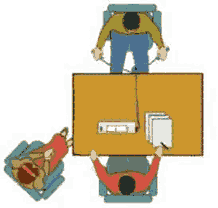Home Search Level 0 Level 1 Level 2 Level 3 Level 4 Level 4Pro Level 5 C/Sing Solo
| Tech terms | Scales | Axioms | Drills | Checksheets | Processes | Prep. lists | C/S terms | C/S tool | Grades | Cramm | Points | KTW | Online |
|
Home Search Level 0 Level 1 Level 2 Level 3 Level 4 Level 4Pro Level 5 C/Sing Solo |
|
|
| Tech terms | Scales | Axioms | Drills | Checksheets | Processes | Prep. lists | C/S terms | C/S tool | Grades | Cramm | Points | KTW | Online | |
Marriage Confessional
A Marriage Confessional is actually an assist. It can handle difficulties in a marriage and restore ARC in the relationship. It is done by a Class 2 auditor in session.
Both spouses are in the auditing room at the same time. One spouse is on the Meter as a pc; the other spouse sits next to the auditor and hears the confession as it is mainly directed at her (see illustration). The spouses will in turn be run on the confessional process with the other spouse present and will thus get off their Overts and Withholds on each other in a safe environment.
 |
In this illustration the |
Here are the steps:
Both spouses have of have an
understanding of auditing. If any of them are new to the activity, this
person has to be taken through the Basic
definitions of auditing so he/she knows what is going on.
Explain that the Confessional will be
done under Auditors Code, including be kept confidential. The spouse
listening in has to understand, that she is not to interrupt or comment
during the auditing of the spouse. (If it should happen anyway, see it as an
origination and handle with ARC).
Explain how you will go about doing the
action and what is expected of each.
Explain, when you have finished the
session, you will take both to the Examiner, where they will be checked on
the Meter and can make a statement. Both spouses are given an Exam.
Put the one spouse on the Meter (we use
husband in the explanation). Set the sensitivity for this pc per Meter drills
and check that he is sessionable.
Clear the words, 'Moral code', 'Overt
act' and 'Withhold' thoroughly.
Clear the commands with him per Clearing
Commands. Make sure he has a good grip of 'Done' (Overts) and 'Withheld'
(Withholds) in the commands.
The Commands are:
(1) What have you done to (spouse's name)?
(2) What have you withheld from (spouse's name)?
Run the process alternately (1,2,1,2)
until the pc has an F/N cognition and VGI.
Indicate the F/N and tell him, that this
step is complete and it is now the wife's turn to hold the cans.
You put the wife on the cans. You keep
separate worksheets for the two so it can be filed in their respective pc
folders.
You now clear the commands with her as
above. The husband is now sitting next to the auditor and listening to her
confession.
The auditor does the process on the wife
to F/N, cog and VGI's. Then indicates the F/N and tells her this step is now
complete on her.
When the auditor ends the session for
the day or for a meal break, both spouses are taken to Examiner and in turn
given an Exam (needle, statement).
The auditor keeps two separate reports
for the spouses and keep their auditing in their folder. He does however
make one set of photo copies and include the copy in the spouse's folder.
This is so
the C/S can see the whole session in context by looking in one folder at the
time. (Especially important for later reviews of the auditing, if needed).
The next session would be to put the
husband on the cans again and run some more of the process to a new cog,
F/N, VGI's is reached.
The spouses are run in turn until the EP
of the confessional is reached.
End Phenomena of the Action
The action is continued until the TA has
gone flat on both spouses. When the process no longer produces TA it is flat
by TA. Each turn, including the last one, should go to F/N, cog, VGI's. If
overrun beyond going flat by TA the EP should be rehabbed by rehab procedure.
The spouses have come clean in their relationship and they can now start to
rebuild their marriage.
If they are both happy about the session or sessions they can attest being complete on the assist.
 |
With communication |
Repairs
Ordinary upsets or problems in this action are usually due to Missed Withholds and are handled by simply continuing the process or pull the Missed Withholds. If the action should get into serious trouble and the pc refuses to go on, the action is repaired with a Confessional Repair List (LCRE).
This action would be done on the pc without the spouse being present. If the repair brings up additional Overts and Withholds on the spouse, these have to be revealed. This is simply done by telling them to the spouse at the beginning of the next session where they are both present.
Before the auditor resorts to a repair list he should make sure, that it is otherwise an impasse. It is not unusual for both spouses to be emotional and express being upset with the other. The first rule is: "Get the pc through it". Here it means it will usually resolve with using good TR-4 and then continue the process. TR-4 may include addressing both parties as you are really auditing their marriage and not just one pc. Only if TR-4 and continue proves to be unworkable would the auditor use a repair list.
Notes on a full marriage
counseling program:
From Clearbird's publication Ethics and Auditing.
A couple that is having a rough time should have
their Admin Scale sorted out. This is a natural part of marriage counseling.
First the couple would sort out ethical issues, including coming clean with each
other by doing write-ups of their Overts and Withholds on the spouse. They would
do the Lower Conditions related to their marriage. Such a program would also
include the couple doing TRs (communication drills, TR 0-4) with each other.
When they can rationally communicate with each other they would be seated with a
counselor and work out an Admin Scale for their marriage.
From Clearbird's 'Ethics and Auditing'. Chapter: Admin Scales - Examples.
Note, that having an auditor do the Marriage Confessional is superior to having the spouses doing an O/W write-up on their own, of course.
FLAT BY TA, the test of "flat" is, the TA moving only one-quarter to one-eighth of a division up or down in twenty minutes of auditing; not cumulative movement such as "the TA moves 1/16th twice so that's 1/8th of a division-" This is wrong. If it moves from 2.25 to 2.50 to 2.25 two or three times in twenty minutes, this is called flat and has moved only one-quarter of a TA division. This is right.
|
Home Search Level 0 Level 1 Level 2 Level 3 Level 4 Level 4Pro Level 5 C/Sing Solo |
|
|
| Tech terms | Scales | Axioms | Drills | Checksheets | Processes | Prep. lists | C/S terms | C/S tool | Grades | Cramm | Points | KTW | Online | |